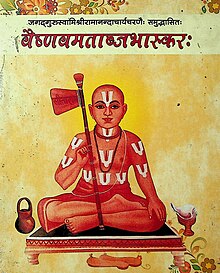| Vaishnava Matabja Bhaskara | |
|---|---|
 Ramananda with his Tridanda | |
| Information | |
| Religion | Hinduism |
| Author | Ramananda |
| Language | Sanskrit |
| Chapters | 10 |
| Verses | 204 |
The Vaishnava Matabja Bhaskara (IAST: Vaiṣṇava Mātābja Bhāskara, Sanskrit: वैष्णवमताब्जभास्कर:) is one of the most prominent works of Ramananda[1] in Sanskrit. This work is a dialogue between Ramananda and his disciple named Surasurananda.
In the Vaishnava Matabja Bhaskara, Ramananda has answered the 10 most prominent questions related to Vaishnavism. Its primary focus is worship of Rama along with Sita and Lakshmana.[2] The text mentions that one's devotion should be like flowing oil which means consistent or unbreakable.[3] According to this text, the ultimate goal of a person is the attainment of Rama as he is one who resides in everyone's heart and is the protector of whole universe and who is known through Upanishads.[4] By practicing under the guidance of a guru, a person reaches the divine abode, Saketa, where one attains the proximity of Sri Rama. From there, one does not return to this earthly realm.[4] The philosophy of Ramcharit Manas is also in accordance to Vaishnava Matabja Bhaskara.[4] The text also states that every individual irrespective of his colour, gender, caste, background etc. is worthy of Sharnagati unto the holy Lotus feet of Rama, Ramananda in his Vaishnava Matabja Bhaskara says:[5]
सर्वे प्रपत्तेरधिकारिणः सदा शक्ता अशक्ता पदयोर्जगत्प्रभोः । अपेक्ष्यते तत्र कुलं बलञ्च नो न चापि कालो न च शुद्धतापि वै ॥ Everyone has the right to seek refuge in Lord Shri Ram, regardless of their capabilities, as the supremely compassionate Lord does not expect the strength of high lineage, knowledge, appropriate timing, or any kind of purification for accepting one at His divine feet. Hence, every individual is entitled to attain the grace of the Divine.—Vaishnava Matabja Bhaskara Chapter 4
तप्तेन मूले भुजयोः समङ्कनं शरेण चापेन तथोर्ध्वपुण्ड्रकम् ।
श्रुतिश्रुतं नाम च मन्त्रमालिके संस्कारभेदाः परमार्थहेतवः ॥
This translates to: The Vedic rituals of imprinting the bow and arrow on the arm, wearing the vertical tilak mark, Urdhvapundra, adopting names associated with devotion unto Rama (such as dasānta, prapannanta, or sharananta), always wearing a tulasi bead around the neck, and receiving the instruction of the six-syllabled Ramataraka Mantra from a Vaishnava acharya, are considered essential for spiritual liberation in Vaishnavism.[9]
धृतोर्ध्वपुण्ड्रस्तुलसीसमुद्भवां दधच्च कण्ठे शुभमालिकां जनः । तज्जन्मकर्माणि हरेरुदाहरेद् गृह्णंश्च नामानि शुभप्रदानि सः ॥
This Translates to: A person who wears the upward-pointing tilaka (urdhva pundra) on twelve places of their body and adorn themselves with the sacred Tulsi bead around their neck, while singing and chanting the divine names and pastimes of Rama's incarnations, is considered a Vaishnava.[12]
प्रातर्मध्याह्नसायं कृतशुचिकृतिभिः राममभ्यर्च्य सम्यक् श्रीमद्रामायणेन प्रतिदिनमखिलैर्भारतेन प्रपन्नैः । शक्तैरानन्दभाष्यैरथ च शुभतमाचार्यदिव्यप्रबन्धैः कालक्षेपो विधेयः सुविजितकरणैः स्वाकृतेर्यावदन्तम् ॥
This Translates to: A self-disciplined Vaishnava, having control over their senses, should, every morning, noon, and evening, conclude their cleansing rituals and worship Sita-Rama. Following this, they should engage in the study of sacred scriptures like the Ramayana, Mahabharata, Bhagavata, and Vaishnava texts like Anandabhashya to enrich their spiritual knowledge.
Further in this chapter Ramananda says, "If unable to perform the aforementioned practices, one should listen to these sacred texts after the daily cleansing rituals. If that's also not possible, then engaging in chanting the name of Sri Sita-Rama is recommended. If that too isn't feasible, then one should continually seek and meditate upon the divine Dvaya-mantra of Sri Rama." This shows that Ramananda has not let any stone unturned to easy the path of bhakti.[13]